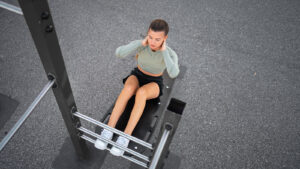If you do pilates, you’ve probably heard people talking about core activation and bracing. But what exactly do these terms mean, and how much do they overlap?
As you may already know, pilates is a discipline that involves the body and mind working together to create a more stable centre core. As well as being good for your bones pilates also supports your spine and improves your general body alignment. Whether dynamic or static, you carry out a pilates movement at your own ideal intensity and boost your core strength.
What is the core?
You probably already know what the core is, but let’s have a refresher. Your core muscles are deep in your body – not the visible abdominal muscles. It’s not a six-pack. Your core comprises your transverse abdominis, diaphragm, multifidus, and pelvic floor. You do not suck in your abdominal muscles when you activate your core.
So why activate your core?
Having both solid abdominal muscles and a strong core is equally important. Of course, you strengthen your abdominal muscles when you do exercises like sit-ups or planks, but what about your core?
How to activate your core
If you want to work on your core, you’ll need to activate it first. The easiest way is to get into your neutral spine position. Then, just stand gently like normal.
When you’ve found your neutral spine position, you must place your fingertips onto the bony prominences on each side of your pelvis. When you’ve done this, move your fingertips about an inch inwards and downwards from these points. You will have found the deep internal oblique and transverse abdominis muscles.
You can now begin activating your core! Try tucking your stomach like you’re about to adjust your belt. You should feel a slight tension without the muscle bulging. You can then change your effort into this contraction to feel only a light tension.
What is bracing, then?
Now that you’ve found your transverse abdominis contraction, you know how to activate your core. So, how does this compare to bracing?
Well, bracing is contracting too. However, bracing is contracting to 100% rather than just gently. This is because when you brace, you use all your muscles together but with little control.
Whereas, when you carry out a more gentle contraction of your transverse abdominis, as described above, you develop the ability to activate your inner core. Being able to move with the strength that comes from an activated inner core is the goal of pilates, rather than having a braced core.
Should I do more challenging exercises?
Exercises like planking, side planking and sit-ups are still very beneficial. These difficult exercises can help you build your core muscles and strengthen your body. However, if you do these exercises a lot before you have perfected your inner core activation and muscular control, you’ll end up bracing your abdominal to carry them out. This is why beginning with low-level pilates to work on your inner core activation before you do anything else is so important.
That’s not to say that you shouldn’t ever do planks or sit-ups, but just be careful not to end up bracing, to begin with!

What are some good core training exercises?
The ultimate goal of your core muscles is stabilising your spine during movement; therefore, the next step is seeing if you can find your neutral spine and activate your TA in various positions. Try the above exercise in both sitting and standing before progressing.
After finding your neutral pelvis and activating your core muscles try the following exercises to challenge the TA:
Bent knee, fallout
- Beginning on your back, bend your knees. Keep your knees and feet hip-width apart.
- Activate your core, keeping your pelvis as still as you can.
- Allow one knee to drop to the side.
- Bring your knee out as far as possible, but don’t lose control of your pelvis’s position.
- Bring your knee back to the middle and repeat this with the other side.
Try this exercise at least 5 times on each side.
Leg extensions
- With your knees bent and in a neutral spine position, activate your core and hold the position.
- While holding this position, and keeping your core activated, straighten one leg.
- Now bring the leg back.
Now do this again on the other side!
Of course, training your core’s deep muscles without being 100% certain of the problem and without a thorough assessment is never a good idea. That’s why we recommend you book an appointment with us before you do anything else. This way, we can get to the bottom of your pain and determine what is best for you before recommending the next step.
